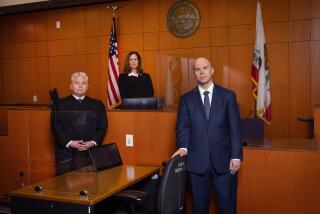Judicially Sound : Infrared Device Lowers Level of Noise in Court by Translating Translations to Beams of Light
- Share via
The courtroom came to order with barely a murmur, despite 80 prospective jurors, four Peruvian defendants and their Spanish language interpreters, six attorneys and other court personnel.
Jampacked as the San Fernando Superior Court chamber was last week, observers could hear easily as Los Angeles County Deputy Dist. Atty. Kenneth A. Loveman questioned a prospective juror on the pronunciation of her name.
Not so a month ago when the multi-defendant trial began. At that time, four interpreters--one for each defendant--simultaneously interpreted the proceedings out loud. The interpreters sat close enough to the defendants to whisper in their ears, but the sound was distracting to other court personnel.
“You had to strain to hear,” said Deputy Sheriff Del Coleman, one of the bailiffs. “Now I can hear everything without even trying.”
Interpreter Paula Krawiec concurs: “We had to keep telling each other to speak lower so we could hear what was going on. Now it’s so quiet.”
The hero of the story is a Sennheiser, an unobtrusive black box used for the first time in a San Fernando Valley courtroom. By transmitting sound via infrared light to each of the defendants, it has cut the need for interpreters from four to one.
Now the four Spanish-speaking defendants listen to their translations through wireless earphones, while a single interpreter speaks softly into a microphone attached by a long cord to the box.
The primary reason the system is highly valued--Judge Howard J. Schwab has kiddingly warned that he will lock it in his office so other judges cannot vie for it--is its effectiveness in reducing noise in the courtroom during multi-defendant cases. It also is credited with speeding up court proceedings and saving the county money.
“We can pay attention to what’s going on before us and not worry about what’s going on behind us where the defendants and translators sit,” defense lawyer Dennis Mulcahy said. “That means fewer interruptions.”
Likewise Loveman said the Sennheiser, named after its inventor, has made his job easier.
“It was hard enough hearing what anyone had to say with five defense attorneys trying to get the floor and making sure I don’t,” Loveman said. “But when they’re each backed up with four translators talking at the same time, it was rather annoying for all court personnel who were trying to concentrate on the matters at hand. There’s been a great improvement with the infrared system.”
Interpreters and their supervisors are also pleased. Instead of having to interpret nonstop in a noisy atmosphere for hours, they take turns for 20 minutes at a time speaking into the microphone attached to the transmitter. They can hear better because they don’t have to whisper in the defendant’s ear and are free to move around the courtroom, interpreter George Rimalower said.
“I wish we had one for every branch of the Superior Court,” said Hanne Mintz, a linguistics specialist for the county court interpreter’s office.
Becoming Common
Used at the downtown branch of Los Angeles Superior Court since 1985, the infrared interpretation machine is becoming a more common feature of courtrooms throughout the 12-branch system as the demand for interpreting services grows, court officials said.
But the machine is not likely to replace human interpreters because of a 1984 California Supreme Court decision that established the right of each non-English speaking person in a multi-defendant trial to his own interpreter.
Burdette L. Harris, director of court staff services for Los Angeles Superior Court, said the $3,500 infrared interpreting systems, which are manufactured in West Germany and distributed by Rolls Electronics Corp. of North Hollywood, could save the court money and reduce demand for interpreters.
The court owns two such systems, which are named after Fritz Sennheiser, the inventor. Harris said the county plans to buy more Sennheisers if budget requests are approved. While using the Sennheisers, the county saves salaries it might have had to pay to interpreters, who charge $156 a day and $102 for a half day, Mintz said.
Increasing Demand
In general, the court is hard-pressed to supply enough interpreters to satisfy the increasing demand, Mintz said.
Pat H. Martin, staff assistant with the court staff services division of Superior Court, said an average of about 224 interpreters worked each day in 1986, an increase of 16% from the 198 a day who worked in Los Angeles Superior Court in 1985.
Although Spanish is the most common language, at least 80 other tongues ranging from Berber, an East Indian dialect, to Chuchow, a form of Chinese, are translated by interpreters. Korean is the second most common language in the courts, Mintz said.
Interpreters themselves do not appear worried about automation taking over their jobs. With Los Angeles’ Asian and Hispanic populations growing, they can be sure of the demand for their services.
Interpreter Alberto Ortiz said, “I wish each new courtroom that was built had an interpreter’s soundproof booth equipped with an infrared system. Then it would really be quiet in the courts.”
More to Read
Sign up for Essential California
The most important California stories and recommendations in your inbox every morning.
You may occasionally receive promotional content from the Los Angeles Times.










